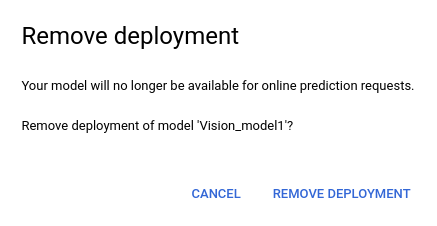Setelah men-deploy dan membuat prediksi, Anda dapat membatalkan deployment model secara manual untuk menghindari biaya tambahan.
Membatalkan deployment contoh kode
UI Web
Buka Vision Dashboard dan pilih tab Model (dengan ikon bohlam) di menu navigasi sebelah kiri untuk menampilkan model yang tersedia.
Untuk melihat model project yang berbeda, pilih project dari menu drop-down di kanan atas panel judul.
- Pilih baris untuk model yang ingin Anda gunakan untuk memberi label pada gambar.
- Pilih tab Pengujian & Penggunaan tepat di bawah panel judul.
-
Pilih Hapus deployment dari banner di bawah nama model Anda untuk membuka jendela opsi batalkan deployment.

-
Pilih Hapus deployment untuk membatalkan deployment model.


-
Anda akan menerima email saat pembatalan deployment model selesai.
REST
Sebelum menggunakan salah satu data permintaan, lakukan penggantian berikut:
- project-id: Project ID GCP Anda.
- model-id: ID model Anda, dari
respons saat membuat model. ID adalah elemen terakhir dari nama model Anda.
Misalnya:
- nama model:
projects/project-id/locations/location-id/models/IOD4412217016962778756 - id model:
IOD4412217016962778756
- nama model:
Metode HTTP dan URL:
POST https://automl.googleapis.com/v1/projects/PROJECT_ID/locations/us- central1/models/MODEL_ID:undeploy
Untuk mengirim permintaan Anda, pilih salah satu opsi berikut:
curl
Jalankan perintah berikut:
curl -X POST \
-H "Authorization: Bearer $(gcloud auth print-access-token)" \
-H "x-goog-user-project: project-id" \
-H "Content-Type: application/json; charset=utf-8" \
-d "" \
"https://automl.googleapis.com/v1/projects/PROJECT_ID/locations/us- central1/models/MODEL_ID:undeploy"
PowerShell
Jalankan perintah berikut:
$cred = gcloud auth print-access-token
$headers = @{ "Authorization" = "Bearer $cred"; "x-goog-user-project" = "project-id" }
Invoke-WebRequest `
-Method POST `
-Headers $headers `
-Uri "https://automl.googleapis.com/v1/projects/PROJECT_ID/locations/us- central1/models/MODEL_ID:undeploy" | Select-Object -Expand Content
{
"name": "projects/PROJECT_ID/locations/us-central1/operations/OPERATION_ID",
"metadata": {
"@type": "type.googleapis.com/google.cloud.automl.v1.OperationMetadata",
"createTime": "2019-08-07T22:19:50.828033Z",
"updateTime": "2019-08-07T22:19:50.828033Z",
"undeployModelDetails": {}
}
}
Anda dapat mendapatkan status operasi dengan metode HTTP dan URL berikut:
GET https://automl.googleapis.com/v1/projects/PROJECT_ID/locations/us-central1/operations/OPERATION_ID
Status operasi yang selesai akan terlihat mirip dengan status berikut:
{
"name": "projects/PROJECT_ID/locations/us-central1/operations/OPERATION_ID",
"metadata": {
"@type": "type.googleapis.com/google.cloud.automl.v1.OperationMetadata",
"createTime": "2019-06-21T16:47:21.704674Z",
"updateTime": "2019-06-21T17:01:00.802505Z",
"deployModelDetails": {}
},
"done": true,
"response": {
"@type": "type.googleapis.com/google.protobuf.Empty"
}
}
Go
Sebelum mencoba contoh ini, ikuti petunjuk penyiapan untuk bahasa ini di halaman Library Klien.
Java
Sebelum mencoba contoh ini, ikuti petunjuk penyiapan untuk bahasa ini di halaman Library Klien.
Node.js
Sebelum mencoba contoh ini, ikuti petunjuk penyiapan untuk bahasa ini di halaman Library Klien.
Python
Sebelum mencoba contoh ini, ikuti petunjuk penyiapan untuk bahasa ini di halaman Library Klien.
Bahasa tambahan
C# : Ikuti Petunjuk penyiapan C# di halaman library klien, lalu kunjungi dokumentasi referensi AutoML Vision untuk .NET.
PHP : Ikuti Petunjuk penyiapan PHP di halaman library klien, lalu kunjungi dokumentasi referensi AutoML Vision untuk PHP.
Ruby : Ikuti Petunjuk penyiapan Ruby di halaman library klien, lalu kunjungi dokumentasi referensi AutoML Vision untuk Ruby.
